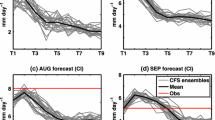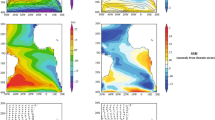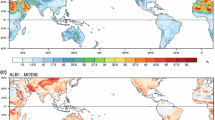Abstract
Most of current general circulation models (GCMs) show a remarkable positive precipitation bias over the southwestern equatorial Indian Ocean (SWEIO), which can be thought of as a westward expansion of the simulated IO convergence zone toward the coast of Africa. The bias is common to both coupled and uncoupled models, suggesting that its origin does not stem from the way boundary conditions are specified. The spatio-temporal evolution of the precipitation and associated three-dimensional atmospheric circulation biases is comprehensively characterized by comparing the GFDL AM3 atmospheric model to observations. It is shown that the oceanic bias, which develops in spring and reduces during the monsoon season, is associated to a consistent precipitation and circulation anomalous pattern over the whole Indian region. In the vertical, the areas are linked by an anomalous Hadley-type meridional circulation, whose northern branch subsides over northeastern India significantly affecting the monsoon evolution (e.g., delaying its onset). This study makes the case that the precipitation bias over the SWEIO is forced by the model excess response to the local meridional sea surface temperature (SST) gradient through enhanced near-surface meridional wind convergence. This is suggested by observational evidence and supported by AM3 sensitivity experiments. The latter show that relaxing the magnitude of the meridional SST gradient in the SWEIO can lead to a significant reduction of both local and large-scale precipitation and circulation biases. The ability of local anomalies over the SWEIO to force a large-scale remote response to the north is further supported by numerical experiments with the GFDL spectral dry dynamical core model. By imposing a realistic anomalous heating source over the SWEIO the model is able to reproduce the main dynamical features of the AM3 bias. These results indicate that improved GCM simulations of the South Asian summer monsoon could be achieved by reducing the springtime model bias over the SWEIO. Deficiencies in the atmospheric model, and in particular in the convective parameterization, are suggested to play a key role. Finally, the important mechanism controlling the simulated precipitation distribution over South Asia found here should be considered in the interpretation and attribution of regional precipitation variation under climate change.








Similar content being viewed by others
Notes
The analysis presented in Fig. 1e was also conducted with a multi-model average of coupled model intercomparison project phase 3 (CMIP3) GCMs, and with the GFDL coupled climate model CM3, of which AM3 is the atmospheric component. The biases in precipitation and low-level circulation, not displayed here for brevity, grossly resemble those of AM3, especially along the equatorial IO.
Since global observations of PBL height are not available, the ERA40 PBL is used as “observations” for this qualitative analysis. von Engeln and Texeira (2010) estimate a springtime PBL height of about 1,250 m over the SWEIO, comparable to the ~1,000 m from the ERA40 climatology. Both estimates are much higher than the AM3 values (~600 m).
The average SST values between 35°S and 20°N are 26.97 ° and 27.03 °C for the idealized and actual profiles, respectively, while the root mean square difference is 0.54 °C. South of 35°S a relatively abrupt transition between the idealized and actual SST profiles exists, which could be smoothed out. At this time, this critical latitude was considered to be located sufficiently southward of the targeted precipitation region to avoid any substantial impact on the area of interest, given the preliminary and mostly qualitative nature of these experiments.
A control and an “additional heating” experiments were also performed with a steady, linear primitive equation model (Bollasina and Nigam 2011) forced by ERA-40 climatological mean fields, including three-dimensional diabatic heating. The “additional heating” experiment consisted in prescribing a positive diabatic heating anomaly over the SWEIO mimicking the AM3 precipitation bias during May. The simulated equilibrium response is consistent with the dry dynamical model response at t = 10 days.
The mean flow plays an important role in determining the growth and propagation of waves from the perturbed region. During May upper-level weak easterlies (~5–10 m s−1) lie over the region of the prescribed heating and northward to about 10°N, which tend to dampen the amplitude of the Rossby wave response. However, the strong westerlies (~25 m s−1) over northern India facilitate the growth of Rossby waves.
References
Adler RF, Huffman GJ, Chang A, Ferraro R, Xie P, Janowiak J, Rudolf B, Schneider U, Curtis S, Bolvin D, Gruber A, Susskind J, Arkin P, Nelkin E (2003) The version 2 global precipitation climatology project (GPCP) monthly precipitation analysis (1979-present). J Hydrometeorol 4:1147–1167
Annamalai H, Liu P, Xie SP (2005) Southwest Indian Ocean SST variability: its local effect and remote influence on Asian monsoons. J Clim 18:4150–4167
Annamalai H, Hamilton K, Sperber KR (2007) South Asian summer monsoon and its relationship with ENSO in the IPCC AR4 simulations. J Clim 20:1071–1092
Back LE, Bretherton CS (2009) On the relationship between SST gradients, boundary layer winds and convergence over the tropical oceans. J Clim 22:4182–4196
Biasutti M, Sobel AH, Kushnir Y (2006) AGCM precipitation biases in the tropical Atlantic. J Clim 19:935–958
Bollasina M, Nigam S (2008) Indian Ocean SST, evaporation, and precipitation during the South Asian summer monsoon in IPCC-AR4 coupled simulations. Clim Dyn 33:1017–1033
Bollasina M, Nigam S (2011) The summertime “heat” low over Pakistan/northwestern India: evolution and origin. Clim Dyn 37:957–970
Cash BA, Rodo X, Kinter JL, Fennessy MJ, Doty B (2008) Differing estimates of observed Bangladesh summer rainfall. J Hydrometeorol 9:1106–1114
Chiang JCH, Zebiak SE, Cane MA (2001) Relative roles of elevated heating and surface temperature gradients in driving anomalous surface winds over tropical oceans. J Atmos Sci 58:1371–1394
Chung CE, Ramanathan V (2006) Weakening of North Indian SST gradients and the monsoon rainfall in India and the Sahel. J Clim 19:2036–2045
Copsey D, Sutton R, Knight JR (2006) Recent trends in sea level pressure in the Indian Ocean region. Geophys Res Lett 33:L19712. doi:10.1029/2006GL027175
Das PK (1962) Mean vertical motion and non-adiabatic heat sources over India during the monsoon. Tellus 14:212–220
DeWeaver ET, Nigam S (2004) On the forcing of ENSO teleconnections by anomalous heating and cooling. J Clim 17:3225–3235
Donner LJ et al (2011) The dynamical core, physical parameterizations, and basic simulation characteristics of the atmospheric component AM3 of the GFDL global coupled model CM3. J Clim 24:3484–3519
Fu X, Wang B, Li T (2002) Impacts of air–sea coupling on the simulation of mean Asian summer monsoon in the ECHAM4 model. Mon Weather Rev 130:2889–2904
Gadgil S (2003) The Indian monsoon and its variability. Annu Rev Earth Planet Sci 8:429–467
Gadgil S, Sajani S (1998) Monsoon precipitation in the AMIP runs. Clim Dyn 14:659–689
Gadgil S, Joseph PV, Joshi NV (1984) Ocean atmosphere coupling over monsoon regions. Nature 312:141–143
Goswami BN (2005) South Asian summer monsoon: an overview. In: Chang C-P, Wang B, Lau N-CG (eds) The global monsoon system: research and forecast. WMO/TD no. 1266 (TMRP report no. 70), pp 47–71
Grabowski WW, Yano JI, Moncrieff MW (2000) Cloud resolving modeling of tropical circulations driven by large-scale SST gradients. J Atmos Sci 57:2022–2040
Graham N, Barnett TP (1987) Sea surface temperature, surface wind divergence, and convection over tropical oceans. Science 238:657–659
Held IM, Suarez MJ (1994) A proposal for the intercomparison of the dynamical cores of atmospheric general circulation models. Bull Amer Meteor Soc 73:1825–1830
Helsel DR, Hirsch RM (2002) Statistical Methods in water resources techniques of water resources investigations, book 4, chapter A3. U.S. Geological Survey, p 522. Available at the web address: http://pubs.usgs.gov/twri/twri4a3/
Huffman GJ, Adler RF, Bolvin DT, Gu G, Nelkin EJ, Bowman KP, Hong Y, Stocker EF, Wolff DB (2007) The TRMM Multisatellite Precipitation Analysis (TMPA): quasi-global, multiyear, combined-sensor precipitation estimates at fine scales. J Hydrometeorol 8:38–55
Ihara C, Kushnir Y, Cane MA, de la Peña VH (2009) Climate change over the equatorial Indo-Pacific in global warming. J Clim 22:2678–2693
Jin FF, Hoskins BJ (1995) The direct response to tropical heating in a baroclinic atmosphere. J Atmos Sci 52:307–319
Kang IS, Shukla J (2006) Dynamical seasonal prediction and predictability of the monsoon. In: Wang B (ed) The Asian monsoon. Praxis Pub Ltd., Chichester, pp 585–612
Kang IS et al (2002) Intercomparison of the climatological variations of Asian summer monsoon precipitation simulated by 10 GCMs. Clim Dyn 19:383–395
Kang IS, Lee JY, Park CK (2004) Potential predictability of summer mean precipitation in a dynamical seasonal prediction system with systematic error correction. J Clim 17:834–844
Kim HM, Kang IS (2008) The impact of ocean–atmosphere coupling on the predictability of boreal summer intraseasonal oscillation. Clim Dyn 31:859–870
Kim D, Sobel AH, Maloney ED, Frierson DMW, Kang IS (2011) A systematic relationship between intraseasonal variability and mean state bias in AGCM simulations. J Clim 24:5506–5520
Krishna Kumar K, Hoerling M, Rajagopalan B (2005) Advancing dynamical prediction of Indian monsoon rainfall. Geophys Res Lett 32:L08704. doi:10.1029/2004GL021979
Larson K, Hartmann DL (2003) Interactions among cloud, water vapor, radiation, and large-scale circulation in the tropical climate. Part II: sensitivity to spatial gradients of sea surface temperature. J Clim 16:1441–1455
Lau NC, Nath MJ (2000) Impact of ENSO on the variability of the Asian–Australian monsoons as simulated in GCM experiments. J Clim 13:4287–4309
Li C, Yanai M (1996) The onset and interannual variability of the Asian summer monsoon in relation to land-sea thermal contrast. J Clim 9:358–375
Lin JL (2007) The double-ITCZ problem in IPCC AR4 coupled GCMs: ocean-atmosphere feedback analysis. J Clim 20:4497–4525
Lindzen RS, Nigam S (1987) On the role of sea surface temperature gradients in forcing low level winds and convergence in the tropics. J Atmos Sci 44:2418–2436
Medeiros B, Hall A, Stevens B (2005) What controls the mean depth of the PBL? J Clim 18:3157–3172
Meehl GA, Arblaster JM, Lawrence DM, Seth A, Schneider EK, Kirtman BP, Min D (2006) Monsoon regimes in the CCSM3. J Clim 19:2482–2495
Nolan DS, Zhang C, Chen SH (2007) Dynamics of the shallow meridional circulation around intertropical convergence zones. J Atmos Sci 64:2262–2285
Rajeevan M, Nanjundiah RS (2009) Coupled model simulations of twentieth century climate of the Indian summer monsoon. In: Platinum jubilee special volume of the Indian Academy of Sciences. Indian Academy of Sciences, Bangalore, pp 537–568
Ramage CS (1971) Monsoon meteorology. Academic Press, New York
Rayner NA, Parker DE, Horton EB, Folland CK, Alexander LV, Rowell DP, Kent EC, Kaplan A (2003) Global analyses of sea surface temperature, sea ice, and night marine air temperature since the late nineteenth century. J Geophys Res 108:4407. doi:10.1029/2002JD002670
Rodwell MJ, Hoskins BJ (1996) Monsoons and the dynamics of deserts. Q J R Met Soc 122:1385–1404
Sobel AH (2007) Simple models of ensemble-averaged precipitation and surface wind, given the SST. In: Schneider T, Sobel AH (eds) The global circulation of the atmosphere. Princeton University Press, Princeton, pp 219–251
Sperber KR, Annamalai H (2008) Coupled model simulations of boreal summer intraseasonal (30–50 day) variability, part 1: systematic errors and caution on use of metrics. Clim Dyn 31:354–372
Sperber KR, Palmer T (1996) Interannual tropical rainfall variability in general circulation model simulations associated with the atmospheric model intercomparison project. J Clim 9:2727–2750
Stevens B, Duan J, McWilliams JC, Munnich M, Neelin JD (2002) Entrainment, Rayleigh friction and boundary layer winds over the Tropical Pacific. J Clim 15:30–44
Sumi A, Lau NC, Wang WC (2005) Present Status of Asian Monsoon Simulation. In: Chang C-P, Wang B, Lau N-CG (eds) The global monsoon system: research and forecast, WMO/TD no. 1266 (TMRP report no. 70), pp 376–385
Tomas R, Webster PJ (1997) On the location of the intertropical convergence zone and near-equatorial convection: the role of inertial instability. Q J R Met Soc 123:1445–1482
Uppala SM et al (2005) The ERA40 reanalysis. Q J R Met Soc 131:2961–3012
von Engeln A, Teixeira J (2010) A planetary boundary layer height climatology derived from ECMWF Re-analysis data. J Appl Met Clim (submitted)
Wang B, Kang IS, Li JY (2004) Ensemble simulation of Asian-Australian monsoon variability by 11 AGCMs. J Clim 17:803–818
Wang B, Ding Q, Fu X, Kang IS, Jin K, Shukla J, Doblas-Reyes F (2005) Fundamental challenge in simulation and prediction of summer monsoon rainfall. Geophys Res Lett 32:L15711. doi:10.1029/2005GL022734
Webster PJ (2006) The coupled monsoon system. In: Wang B (ed) The Asian monsoon. Praxis Publishing Ltd., Chichester, pp 3–66
Webster PJ, Magana VO, Palmer TN, Shukla J, Tomas RA, Yanai M, Yasunari T (1998) Monsoons: processes, predictability, and the prospects for prediction. J Geophys Res 103:14451–14510
Wu R, Kirtman BP (2005) Roles of Indian and Pacific Ocean air-sea coupling in tropical atmospheric variability. Clim Dyn 25:155–170
Wu R, Kirtman BP (2007) Regimes of seasonal air-sea interaction and implications for performance of forced simulations. Clim Dyn 29:393–410
Wu R, Kirtman BP, Pegion K (2006) Local air-sea relationship in observations and model simulations. J Clim 19:4914–4932
Wu R, Kirtman BP, Krishnamurthy V (2008) An asymmetric mode of tropical Indian Ocean rainfall variability in boreal spring. J Geophys Res 113:D05104. doi:10.1029/2007JD009316
Xie P, Arkin PA (1997) Global precipitation: a 17-year monthly analysis based on gauge observations, satellite estimates, and numerical model outputs. Bull Amer Meteor Soc 78:2539–2558
Xie SP, Xu H, Saji NH, Wang Y, Liu WT (2006) Role of narrow mountains in large-scale organization of Asian monsoon convection. J Clim 19:3420–3429
Xie SP, Deser C, Vecchi GA, Ma J, Teng H, Wittenberg AT (2010) Global warming pattern formation: sea surface temperature and rainfall. J Clim 23:966–986
Acknowledgments
The authors would like to thank Chris Golaz for helpful discussions. We also thank Takeshi Doi and Matthew Harrison for reviewing an earlier version of the manuscript, as well as two anonymous reviewers for their comments.
Author information
Authors and Affiliations
Corresponding author
Rights and permissions
About this article
Cite this article
Bollasina, M.A., Ming, Y. The general circulation model precipitation bias over the southwestern equatorial Indian Ocean and its implications for simulating the South Asian monsoon. Clim Dyn 40, 823–838 (2013). https://doi.org/10.1007/s00382-012-1347-7
Received:
Accepted:
Published:
Issue Date:
DOI: https://doi.org/10.1007/s00382-012-1347-7




